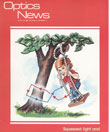
June, 1987 Issue
Feature Articles
Optical coatings in the 1940s: Coating under adverse conditions
Recently Karl H. Guenther of the University of Alabama in Huntsville became a member of the U.S. technical activities group for ISO/TC 172/SC3/WG2, Optical coatings. Soon after, he attended a WG2 meeting in Paris as the U.S. representative and was promptly designated the convener of the group.
by Robert E. ParksCrookes' radiometer in a block of ice
This photograph shows a Crookes' radiometer, an apparatus that is traditionally included in radiometric demonstrations. It consists of a small paddle wheel with four very thin vanes that have been blackened on one side and highly polished on the other side.
by J. H. TaylorOptical coating standards
In the 1980s it is evident that the geographical locations of the institutions in North America that train optical engineers are quite diffuse, ranging from Quebec in Canada to as far south as Tucson, Ariz., and Puebla, Mexico. But in the 1940s, the lion's share of the training was in Rochester, N.Y. There were a few physics departments in the U.S. that trained optical physicists such as the University of California, Berkeley, the Johns Hopkins University, and Massachusetts Institute of Technology.
by Philip BaumeisterSqueezed light
Besides serving as a probe to explore new physical phenomena, squeezed light may have application in sensitive and precision measurement instrumentation. This article describes squeezed state generation via parametric amplification and four-wave mixing.
by B. Yurke and R.E. Slusher

![A multiplexed image of a human tonsil acquired. [NIAID] using the iterative bleaching extends multiplexity (IBEX) method.](https://opnmedia.blob.core.windows.net/$web/opn/media/images/articles/2024/0424/departments/202404-cover-web.jpg?ext=.jpg)
